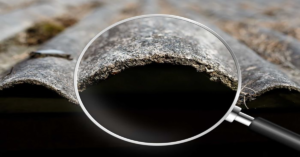Physical Address
23,24,25 & 26, 2nd Floor, Software Technology Park India, Opp: Garware Stadium,MIDC, Chikalthana, Aurangabad, Maharashtra – 431001 India
Physical Address
23,24,25 & 26, 2nd Floor, Software Technology Park India, Opp: Garware Stadium,MIDC, Chikalthana, Aurangabad, Maharashtra – 431001 India

In the global fight against climate change, we’re constantly seeking innovative solutions to tackle the monumental challenge ahead. Amidst the myriad of strategies and technologies being explored, one unlikely candidate has emerged from the shadows: asbestos. Yes, you read that right – the same material once notorious for its deadly health risks is now being reconsidered as a potential ally in our quest to reduce atmospheric carbon dioxide levels.
At first glance, the idea might seem absurd or even reckless. After all, asbestos has long been associated with serious health complications, including mesothelioma and asbestosis, due to the inhalation of its microscopic fibers. However, recent research suggests that under controlled conditions, asbestos could serve as a valuable carbon sink, effectively trapping and storing carbon dioxide from the atmosphere.
But how exactly does asbestos, a mineral with such a tarnished reputation, hold the key to combating climate change? The answer lies in its unique properties and the innovative approaches being developed by scientists around the world.
The Carbon-Capturing Potential of Asbestos
Asbestos, a naturally occurring fibrous silicate mineral, has a history dating back 4,500 years, with extensive mining beginning in the 19th century. Found in rocks like serpentinite/(Mg)3Si2O5(OH)4 (chrysotile [white]) and amphibole (actinolite, amosite [brown], anthophyllite, crocidolite [blue], and tremolite), it was once deemed harmless when undisturbed and covered by soil. However, its manufacturing revealed severe health hazards. Asbestos minerals are widespread globally, primarily in specific rock types and the soils derived from them.
Asbestos boasts a vast surface area, which makes it adept at capturing carbon dioxide molecules. When exposed to carbon dioxide, asbestos undergoes a chemical reaction that forms stable minerals like magnesite and MgCO3, effectively sequestering carbon dioxide from the environment for potentially millennia. This reaction holds promise for harnessing asbestos as a carbon sink, akin to natural reservoirs like forests and oceans.

Pic courtesy Rafael Mattos Dos Santos
One of the most promising avenues for utilizing asbestos as a carbon sink involves repurposing closed asbestos mines. These abandoned sites, once symbols of environmental and health hazards, could be transformed into assets in the fight against climate change.
Based on their research at an asbestos mine that’s been shuttered since 1980, Woodall and his advisor, Jennifer Wilcox, a carbon removal researcher, are among a growing number of scientists who believe that “the vast surface area of certain types of fibrous asbestos, a class of carcinogenic compounds once heavily used in heat-resistant building materials, makes them particularly good at grabbing hold of the carbon dioxide molecules dissolved in rainwater or floating through the air.”.
A professor at the University of British Columbia and one of the leading researchers in this emerging field, Gregory Dipple, says, “Decarbonizing mines in the next decade is just helping us to build confidence and know-how to actually mine for the purpose of negative emissions.”.
Overcoming Hurdles and Shaping the Future
Before delving further into the potential of asbestos in climate mitigation, it’s crucial to address the elephant in the room: health concerns. Asbestos exposure remains a serious risk, with past mining and industrial activities leaving a legacy of environmental contamination and human suffering.
The road to harnessing asbestos for carbon sequestration is not without its challenges and controversies. Environmental concerns, health risks, and logistical hurdles must be carefully addressed and mitigated. Safety measures, strict regulations, and scientific oversight are paramount to ensuring that any efforts involving asbestos are conducted responsibly and ethically.
Furthermore, the potential scale of asbestos-based carbon capture is just a fraction of what’s needed to make a significant impact on global carbon dioxide levels. While asbestos mines may capture millions of tons of carbon dioxide annually, we require solutions on a much larger scale to meet the ambitious targets outlined by climate scientists.
Embracing Innovation for a Sustainable Future
Despite these challenges, the concept of asbestos as a carbon sink represents a fascinating intersection of science, sustainability, and innovation. It challenges us to reconsider our preconceptions and explore unconventional solutions to pressing environmental issues.
Moreover, the exploration of asbestos as a carbon sink underscores the importance of understanding and harnessing the natural world’s capabilities in addressing climate change. From forests to oceans to asbestos mines, nature offers a wealth of resources and mechanisms that, when harnessed responsibly, can help mitigate the impacts of human-induced climate change.
In conclusion, while the idea of asbestos fighting climate change may seem improbable at first glance, it serves as a reminder of the power of human ingenuity and scientific exploration. As we continue to navigate the complexities of climate change, let us remain open-minded to unconventional solutions and bold ideas that have the potential to make a profound difference in shaping a more sustainable future for generations to come.
Despite efforts by scientists to expedite carbon capture and storage using asbestos-containing materials in mines, approximately 67 countries have prohibited its usage, resulting in the closure of many asbestos mines. In Sri Lanka, the use of asbestos-manufactured products is rare, with only a handful of companies still employing them.
However, if asbestos is discovered in homes, residents typically engage services like Calmarc Chemicals Lanka (Pvt) Ltd or SGS Lanka (pvt) Ltd for its safe removal. These companies ensure proper disposal at approved dumping sites to mitigate health risks associated with asbestos exposure in the future.
G. R. Diwyanjalee